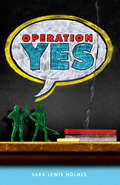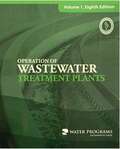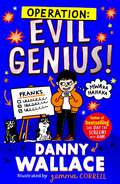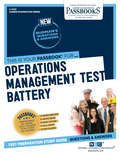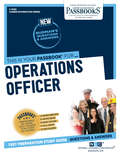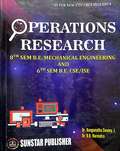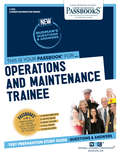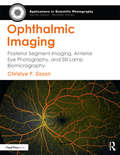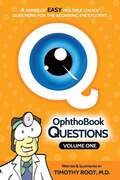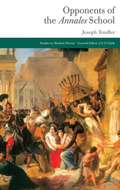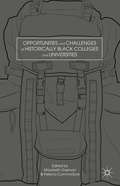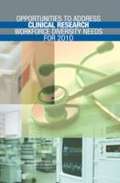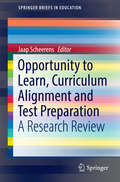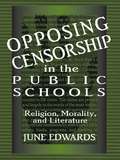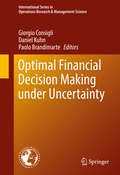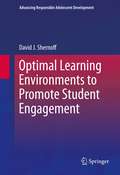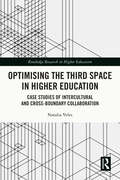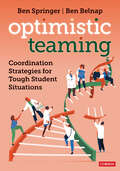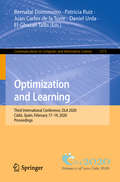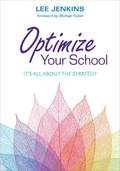- Table View
- List View
Operation Yes
by Sara Lewis HolmesReady? Line UP! FALL IN! And you'll fall for this timely and generous novel set on an Air Force base during the Iraq War, about an amazing teacher and the students she inspires.No one in her sixth-grade class knows quite what to make of Ms. Loupe, with her short hair, her taped square "stage" on the floor, and the interest in improvisational theatre. After all, their school is on an Air Force base--a place that values discipline more than improv. But her students soon come to love her fresh approach; and when her dear brother goes missing in Afghanistan, and Ms. Loupe herself breaks down, they band together to support their teacher. What starts as a class fundraiser expands into a nationwide effort for all injured troops, and an amazing vision of community and hope.
Operation of Wastewater Treatment Plants
by MahmoodOperation of Wastewater Treatment Plants, Volume 1 (8th Edition) is a comprehensive training manual designed to prepare wastewater treatment operators for certification and effective plant operation. Developed by the California State University, Sacramento – Office of Water Programs, this volume presents foundational knowledge and practical techniques required for the safe, efficient, and environmentally responsible management of municipal wastewater treatment systems. The manual covers a wide range of topics including wastewater characteristics, primary and secondary treatment processes, activated sludge systems, safety practices, laboratory procedures, and regulatory compliance. With clearly illustrated diagrams, real-world examples, and review questions, the book serves as a vital resource for students, operators-in-training, and professionals seeking to upgrade their skills. Whether used in a formal course or for self-study, this textbook equips readers with the technical expertise and problem-solving abilities needed to meet the challenges of modern wastewater treatment.
Operation ‘Fox Hunt’
by SiddharthaThoratAn army addicted to power, a soldier prepared for the ultimate sacrifice and a spy who will go to any length to stop him - Operation Fox-Hunt is a tale of sacrifice, camaraderie and betrayal. The Pakistani army, mauled by the Abbottabad raid, decides to create and execute an operation that will get the Pakistani public opinion firmly behind them. Major Shezad Khan, a much decorated officer from the Pakistani army’s elite Special Service Group (SSG) embarks on a mission to attack a strategic target in India. His comrades-in-arms are five ferocious Lashakar-e-Taiba militants. Though he crosses into India through Kashmir, there is one man who has been tasked with the job of ensuring that they don't reach their target. RAW’s Senior Field Agent Sanjay Khanna teams up with Military Intelligence and NSG to thwart the attack. The narrative sweeps across the vast expanses of Tajikistan, the malarial jungles of Bengal, through conflict zones in Baluchistan and the Vale of Kashmir as the two men and their teams race against time. A thrilling finale awaits in the maximum city, Mumbai. Will the Fox-Hunt succeed?
Operation: Evil Genius
by Danny Wallace*PRE-ORDER NOW* What would you do if you woke up one day to find that your best friend has become your worst enemy?That's exactly what happens to 11-year-old Ryan in this brand-new comedy adventure from bestselling author, comedian, and presenter Danny Wallace, perfect for readers age 8+ and fans of Stephen Mangan, Andy Griffiths, Jenny Pearson, Helen Rutter, David Walliams and David Baddiel. Separated only by a garden fence, Ryan and Tom have been best friends since they were two years old. But while Ryan is looking forward to starting secondary school together, Tom doesn't seem to want anything to do him with anymore. Suddenly, he&’d rather hang out with mean Minnie and horrible Simon! Ryan sets out to repair their friendship . . . but everything he tries backfires spectacularly. So Ryan decides that there&’s only one thing for it – he must exact terrible revenge on his ex-best friend. Cue: Operation Evil Genius. There&’s only one problem… every time Ryan tries to make Tom look BAD, he ends up looking GOOD. As it turns out, Ryan is terrible at being terrible! Don&’t miss this hilarious and heart-warming comedy adventure about the magic of true friendship from the bestselling author of The Day the Screens Went Blank. Fully illustrated throughout by Gemma Correll. From the author of highly acclaimed adult bestsellers YES MAN, JOIN ME and the eagerly anticipated SOMEBODY TOLD ME.Other books by Danny Wallace:The Boss of Everyone The Luckiest Kid in the World The Day the Screens Went Blank Hamish and the Worldstoppers Hamish and the Neverpeople Hamish and the Gravity Burp Hamish and the Baby Boom Hamish and the Terrible Terrible Christmas and Other Stories Hamish and the Monster PatrolPraise for The Day the Screens Went Blank: 'So funny' Noel Fielding 'Brilliantly funny' Shappi Khorsandi 'Hilarious' Tim Minchin 'Warm and funny' Frank Cottrell-Boyce
Operations Management Test Battery: Passbooks Study Guide (Career Examination Series)
by National Learning CorporationThe Operations Management Test Battery Passbook® prepares you for your test by allowing you to take practice exams in the subjects you need to study. It provides hundreds of questions and answers in the areas that will likely be covered on your upcoming exam, including but not limited to: workplace learning; arithmetic; knowledge of tools; mechanical comprehension; understanding and interpreting written material; understanding and interpreting graphs, charts and tables; industrial problem solving; and more.
Operations Officer: Passbooks Study Guide (Career Examination Series)
by National Learning CorporationThe Operations Officer Passbook® prepares you for your test by allowing you to take practice exams in the subjects you need to study. It provides hundreds of questions and answers in the areas that will likely be covered on your upcoming exam, including but not limited to: administration; administrative supervision; preparation of written material; understanding and interpreting written material; public relations; and other related areas.
Operations Research for 8th Sem B.E Mechanical Engineering and 6th Sem CSE-ISE
by Ranganatha Swamy L. B. K. NarendraThe author of the book by Dr. Ranganatha Swamy. L. and Dr. B.K. Narendra and published by Sunstar Publisher. This book elucidates the concepts and applications of operations research. Written in a lucid, well-structured and easy-to-understand language, the key topics are explained with adequate depth and details. It is divided into 5 modules. A wide range of solved examples and end-of-chapter exercises makes this book an ideal companion for active learners.
Operations and Maintenance Trainee: Passbooks Study Guide (Career Examination Series)
by National Learning CorporationThe Operations and Maintenance Trainee Passbook® prepares you for your test by allowing you to take practice exams in the subjects you need to study. It provides hundreds of questions and answers in the areas that will likely be covered on your upcoming exam.
Ophthalmic Imaging: Posterior Segment Imaging, Anterior Eye Photography, and Slit Lamp Biomicrography (Applications in Scientific Photography)
by Christye SissonOphthalmic Imaging serves as a reference for the practicing ophthalmic imager. Ophthalmic imaging combines photography and diagnostic imaging to provide insight into not only the health of the eye, but also the health of the human body as a whole. Ophthalmic photographers are specialists in imaging through and in the human eye, one of the only parts of the body where the circulation and nervous system is visible non-invasively. With technical perspective as context, this book will provide instructional techniques as well as the background needed for problem solving in this exciting field. The book covers all aspects of contemporary ophthalmic imaging and provides image support to ophthalmologists and sub-specialties including retinal specialists, corneal specialists, neuro-ophthalmologists, and ocular oncologists. This text serves as a reference for the practicing ophthalmic imager, or to imagers just getting started in the field.
Ophthalmology Made Ridiculously Simple
by Stephen Goldberg William TrattlerAll the ophthalmology most vital for the non-ophthalmologist. This book gives strong emphasis to common disorders, their diagnosis and management at the level of the non-ophthalmologist - up to the point of referral. Included among these are refractive problems, ocular inflammation, trauma, amblyopia, strabismus, and a variety of additional disorders that causes diminished vision or ocular discomfort. Includes interactive download from MedMaster's website with atlas of ophthalmic diseases, as well as movies of common ocular surgical procedures (cataract surgery, lens implantation, Lasik, Lasek, intacs surgery).
Ophthobook Questions - Vol. 1 (Ophthobook Questions Ser.)
by Timothy RootYou've just discovered the coolest question book ever written for the beginning eye student! This book contains over 300 multiple choice questions, sampling every subspecialty within the eye field. It is perfect for the struggling medical student, optometrist, or technician trying to get ahead! 1. These questions are written at a BASIC level for the beginning eye student ... no minutia here! 2. Each question is followed by an explanatory paragraph so you get immediate feedback and learn as you progress! 3. You’ll find hundreds of pictures, cartoons, and mnemonics that improve your retention. Never has studying been this much FUN!
Opponents of the Annales
by Joseph TendlerBased on analysis of archival and published sources, Opponents of the Annales School examines for the first time those who have dared to criticise and ignore one of the most successful currents of thought in modern historiography. It offers an original contribution to the understanding of an unavoidable chapter in modern intellectual history.
Opportunities And Challenges At Historically Black Colleges And Universities
by Marybeth Gasman Felecia CommodoreIn this edited collection, the authors grapple with both the strengths and challenges that HBCUs face as the nation's demographics change, from their place in American society and growing diversity on HBCU campuses to class and elitism issues to study abroad and honors programs.
Opportunities and Challenges for New and Peripheral Political Science Communities: A Consolidated Discipline?
by Gabriella Ilonszki Christophe RouxThis open access book offers an updated examination of the institutionalisation of political science in sixteen latecomer or peripheral countries in Europe. Its main theme is how political science as a science of democracy is influenced and how it responds to the challenges of the new millennium. The chapters, built upon a common theoretical framework of institutionalisation, are evidence-based and comparative. Overall, the book diagnoses diversity among the country cases due to their take-off points and varied political and economic trajectories.
Opportunities to Address Clinical Research Workforce Diversity Needs for 2010
by National Research Council Institute of Medicine of the National AcademiesBased on a 2003 workshop, this study describes current public and private programs and recommends ways to recruit and retain more women and underrepresented minorities into clinical research, especially physician-scientists and nurses. Federal sponsors should improve data collection, evaluate existing training programs, and increase the diversity of study section review panels. Public and private sponsors should create funding mechanisms with flexible career paths, and universities and professional societies should both play enhanced roles in fostering diversity. A significant push is needed to recruit minorities into nursing and provide more clinical research training for nurse-scientists, nursing students, and nursing faculty.
Opportunity to Learn, Curriculum Alignment and Test Preparation
by Jaap ScheerensThis book provides a review of the effectiveness of Opportunity to Learn (OTL) operationalized as the association between OTL and student achievement. In addition, it presents an elaborate conceptual map in which OTL is regarded as part of a larger concept of curriculum alignment. Major components of this framework are national goals and standards, school curricula, formative tests, textbooks, actual delivery of content as part of teaching, and summative tests and examinations. Alignment between educational goals, intended and implemented curricula, and educational outcomes is considered an important prerequisite for effective education. The expectation is that better alignment leads to better student performance. The concept of OTL is commonly used to compare content covered, as part of the implemented curriculum, with student achievement. As such it is to be seen as a facet of the broader concept of "alignment". As it comes to enhancing OTL in educational policy and practice, proactive curriculum development is compared to a more retroactive orientation. Legitimate forms of test and examination preparation belong to this retroactive orientation, and are seen as favorable conditions for optimizing OTL. This book reviews the research evidence on the effects of OTL on student achievement by means of detailed descriptions of key-empirical studies, a review of meta-analyses, a "vote count" syntheses of 51 empirical studies, conducted between 1995 and 2015, and a secondary analysis based on TIMSS 2011, and PISA 2012 data. It concludes that the effect size of OTL, at about . 30, is modest, but comparable in size to other effectiveness-enhancing conditions in schooling. The final chapter of the book provides suggestions for educational policy and practice to further optimize OTL.
Opposing Censorship in Public Schools: Religion, Morality, and Literature
by June EdwardsIn the past several years, hundreds of challenges a year to books used in public schools have been reported across the nation. Most of these have come from the Religious Right. This book confronts the attacks on public education and commonly used literature books by challenging the religious assumptions, the biblical interpretations, and the intimidation tactics of the Religious Right. Part I counters the claims of these censors by presenting opposing views on democracy, secular humanism, religion, the Bible, morality, and the purposes of literature. In Part II, six books frequently taught in high school classes are analyzed. Edwards shows why they have been challenged by the Religious Right, and presents a case for their moral and religious virtues as well as their literary worth. The book differs from other anti-censorship works because it deals primarily and directly with the religious and moral aspects that educators often tend to avoid. This book offers teachers and school administrators scholarly conterarguments that can help confront with literature challenges from the Religious Right.
Optimal Financial Decision Making under Uncertainty
by Daniel Kuhn Giorgio Consigli Paolo BrandimarteThe scope of this volume is primarily to analyze from different methodological perspectives similar valuation and optimization problems arising in financial applications, aimed at facilitating a theoretical and computational integration between methods largely regarded as alternatives. Increasingly in recent years, financial management problems such as strategic asset allocation, asset-liability management, as well as asset pricing problems, have been presented in the literature adopting formulation and solution approaches rooted in stochastic programming, robust optimization, stochastic dynamic programming (including approximate SDP) methods, as well as policy rule optimization, heuristic approaches and others. The aim of the volume is to facilitate the comprehension of the modeling and methodological potentials of those methods, thus their common assumptions and peculiarities, relying on similar financial problems. The volume will address different valuation problems common in finance related to: asset pricing, optimal portfolio management, risk measurement, risk control and asset-liability management. The volume features chapters of theoretical and practical relevance clarifying recent advances in the associated applied field from different standpoints, relying on similar valuation problems and, as mentioned, facilitating a mutual and beneficial methodological and theoretical knowledge transfer. The distinctive aspects of the volume can be summarized as follows: Strong benchmarking philosophy, with contributors explicitly asked to underline current limits and desirable developments in their areas. Theoretical contributions, aimed at advancing the state-of-the-art in the given domain with a clear potential for applications The inclusion of an algorithmic-computational discussion of issues arising on similar valuation problems across different methods. Variety of applications: rarely is it possible within a single volume to consider and analyze different, and possibly competing, alternative optimization techniques applied to well-identified financial valuation problems. Clear definition of the current state-of-the-art in each methodological and applied area to facilitate future research directions.
Optimal Learning Environments to Promote Student Engagement
by David J. ShernoffOptimal Learning Environments to Promote Student Engagement analyzes the psychological, social, and academic phenomena comprising engagement, framing it as critical to learning and development. Drawing on positive psychology, flow studies, and theories of motivation, the book conceptualizes engagement as a learning experience, explaining how it occurs (or not) and how schools can adapt to maximize it among adolescents. Examples of empirically supported environments promoting engagement are provided, representing alternative high schools, Montessori schools, and extracurricular programs. The book identifies key innovations including community-school partnerships, technology-supported learning, and the potential for engaging learning opportunities during an expanded school day. Among the topics covered: Engagement as a primary framework for understanding educational and motivational outcomes.Measuring the malleability, complexity, multidimensionality, and sources of engagement.The relationship between engagement and achievement.Supporting and challenging: the instructor's role in promoting engagement.Engagement within and beyond core academic subjects.Technological innovations on the engagement horizon. Optimal Learning Environments to Promote Student Engagement is an essential resource for researchers, professionals, and graduate students in child and school psychology; social work; educational psychology; positive psychology; family studies; and teaching/teacher education.
Optimising the Third Space in Higher Education: Case Studies of Intercultural and Cross-Boundary Collaboration (Routledge Research in Higher Education)
by Natalia VelesDrawing on an empirical study of the cross-boundary, cross-campus, and intercultural collaborations between professional and academic staff, at both an Australian and a Singaporean university, this book demonstrates the potential of third space collaboration in higher education. Through a multi-case study methodology, the author draws on the antecedent resources of spatial theory to investigate how staff working together, crossing, and transcending various traditional and imaginary boundaries created innovative boundary practices while successfully completing the university projects. The third space projects under investigation range from increasing the academic research visibility and commercialisation of a research solution to expanding the educational choices for students in one geographical region and developing a research culture in one international campus. The findings present practical approaches to strengthening collegiality and professional partnering, challenging the reader to reflect on potential strategies that will apply to their own work environments. This book will be a useful resource for researchers in higher education, particularly those interested in the third space theory and practice, university collaboration, collaborative capital, and impacts of diversification of university staff roles and identities.
Optimistic Teaming: Coordination Strategies for Tough Student Situations
by Ben Springer Ben BelnapUncover innovative and effective ways to confront challenging behavior Complicated and intense student behavior often requires coordinated and powerful support, but that support need not be overwhelming or difficult to implement. Success with the most challenging students requires a team approach. Optimistic Teaming is your ultimate guide to building and sustaining healthy interactions as teams working with challenging students. Drs. Ben Springer and Ben Belnap share humorous insights and critical strategies that help build successful school teams and rally those teams around your students. You′ll discover how to: Remain optimistic and coordinate the best response to even the most aggressive student behaviors Identify the research and evidence base of leveraging optimism individually and in teams Use principles of positive psychology to produce successful outcomes for students and educators alike With this guide, you will discover the framework and strategies to not only remain optimistic, but make lasting, positive changes in the lives of students and their families.
Optimistic Teaming: Coordination Strategies for Tough Student Situations
by Ben Springer Ben BelnapUncover innovative and effective ways to confront challenging behavior Complicated and intense student behavior often requires coordinated and powerful support, but that support need not be overwhelming or difficult to implement. Success with the most challenging students requires a team approach. Optimistic Teaming is your ultimate guide to building and sustaining healthy interactions as teams working with challenging students. Drs. Ben Springer and Ben Belnap share humorous insights and critical strategies that help build successful school teams and rally those teams around your students. You′ll discover how to: Remain optimistic and coordinate the best response to even the most aggressive student behaviors Identify the research and evidence base of leveraging optimism individually and in teams Use principles of positive psychology to produce successful outcomes for students and educators alike With this guide, you will discover the framework and strategies to not only remain optimistic, but make lasting, positive changes in the lives of students and their families.
Optimization and Learning: Third International Conference, OLA 2020, Cádiz, Spain, February 17–19, 2020, Proceedings (Communications in Computer and Information Science #1173)
by Bernabé Dorronsoro Patricia Ruiz El-Ghazali Talbi Juan Carlos de la Torre Daniel UrdaThis volume constitutes the refereed proceedings of the Third International Conference on Optimization and Learning, OLA 2020, held in Cádiz, Spain, in February 2020. The 23 full papers were carefully reviewed and selected from 55 submissions. The papers presented in the volume focus on the future challenges of optimization and learning methods, identifying and exploiting their synergies,and analyzing their applications in different fields, such as health, industry 4.0, games, logistics, etc.
Optimize Your School: It′s All About the Strategy
by Lyle Lee JenkinsLead the change that you want to see in your school! Is your school or district heading in the right direction? In this essential guide for leaders, Lee Jenkins shows how to unite and energize your team as never before, while helping your students to love learning and crave achievement. A trusted advisor to numerous districts, Jenkins knows how to successfully transform school culture – for the long-term. Beginning with an introduction from scholar Michael Fullan, each chapter presents compelling insights and strategies for leaders, addressing how to Evolve your leadership style to guide, empower and serve Apply the principles of continuous strategic improvement as an antidote to win/lose approaches to school accountability Develop a healthy, positive culture of achievement by deeply engaging your students in their own progress and success Turn to this resource and prepare to lead positive change, from the classroom to the staff room and beyond. "This book creates a whole picture approach to school improvement while shunning the current top down model in favor of a school-led plan. The approach not only increases school performances, but values the school-level leadership and instructional faculty." Amanda Mayeaux, Career Management Specialist Iberville Parish Schools "If your district is ready to move from arbitrary to observable, from fractured to focused, and from silos to systems, you’ve found the book that can move entire organizations from a goal mindset to a growth mindset. Lee Jenkins provides common-sense strategies that impact the efficiency and effectiveness of our classrooms, with a clear focus on student growth. In an educational era saturated with the latest remedy for what ails us, Lee provides a refreshing cure by offering simple solutions for lasting change." Dr. Jane Stavem, Associate Superintendent for Instruction Lincoln Public Schools, Lincoln, NE
Optimize Your School: It′s All About the Strategy
by Lyle Lee JenkinsLead the change that you want to see in your school! Is your school or district heading in the right direction? In this essential guide for leaders, Lee Jenkins shows how to unite and energize your team as never before, while helping your students to love learning and crave achievement. A trusted advisor to numerous districts, Jenkins knows how to successfully transform school culture – for the long-term. Beginning with an introduction from scholar Michael Fullan, each chapter presents compelling insights and strategies for leaders, addressing how to Evolve your leadership style to guide, empower and serve Apply the principles of continuous strategic improvement as an antidote to win/lose approaches to school accountability Develop a healthy, positive culture of achievement by deeply engaging your students in their own progress and success Turn to this resource and prepare to lead positive change, from the classroom to the staff room and beyond. "This book creates a whole picture approach to school improvement while shunning the current top down model in favor of a school-led plan. The approach not only increases school performances, but values the school-level leadership and instructional faculty." Amanda Mayeaux, Career Management Specialist Iberville Parish Schools "If your district is ready to move from arbitrary to observable, from fractured to focused, and from silos to systems, you’ve found the book that can move entire organizations from a goal mindset to a growth mindset. Lee Jenkins provides common-sense strategies that impact the efficiency and effectiveness of our classrooms, with a clear focus on student growth. In an educational era saturated with the latest remedy for what ails us, Lee provides a refreshing cure by offering simple solutions for lasting change." Dr. Jane Stavem, Associate Superintendent for Instruction Lincoln Public Schools, Lincoln, NE
